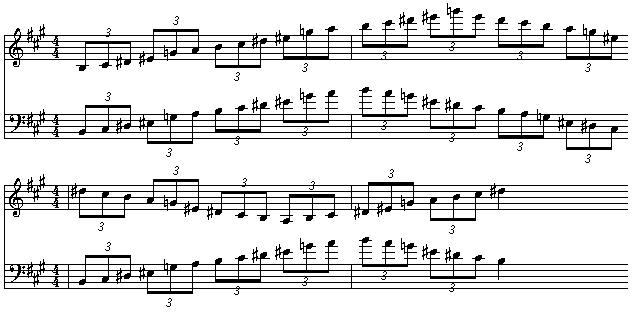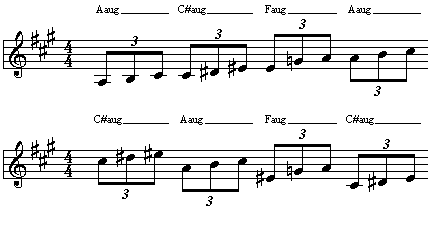Remark: This article requires some understanding of music theory. I'm afraid most people will not understand what I wanted to say. Be warned :)
Camel's first four albums contain long minutes of guitar and keyboard improvisations; The band would often play improvised boogie in live performances. In an interview, Andrew Latimer confesses to be impressed by the dutch group Focus.
Focus was formed in 1969, and released 4 progressive rock albums between 1971 and 1974 - In and Out of Focus, Moving Waves (aka Focus II, Focus 3 and Hamburger Concerto. The driving forces behind the band were the classically trained Thijs van Leer (on Ian-Andersonian-Flute, keyboards, vocals and occasional yodelling) and Jan Akkerman (on Guitar out of hell and an occasional lute). The band experienced with meter changes, odd time signatures (such as 5/4 and 7/8). Most of the music was instrumental, while the introduction of vocals would mainly inject a sense of ludicrous humor.
One may find a similarity, perhaps even an influence, between Focus and Camel.
The Focus song Eruption (from the album Moving Waves, 1972), contains a short guitar riff (written by Jan Akkerman). This riff occurs roughly 9:05 minutes into the song, and you can listen to it here. It is possible that the Latimer/Bardens duo were inspired by Focus' music in while composing and recording the music for The Snow Goose, in 1975. The track Dunkirk contains a similar short riff, roughly at 4:37 into the song. you can listen to it here.
I have isolated the riff and slowed down the speed of the song by half; You can hear the notes played by the guitar and keyboard: Focus sample vs. Camel sample.
Both riffs present a progression over an Augmented Seventh Chord scale. Typically, musicians are familiar with the Diatonic scales (for example, Major and Minor scales are both Diatonic scales), which have 7 notes in each octave. The augmented seventh chord scale has 6 notes in each octave, with a difference of two half-tones between notes. For example, the Augmented Seventh Chord scale at the key of Do (C) contains the following notes: Do, Re, Mi, Fa-sharp, Sol-sharp and La-sharp (C-D-E-F#-G#-A#). The notes on the augmented seventh chord scale at the key of C are the same as in the augmented seventh chord scale at the key of D (D-E-F#-G#-A#-C), E (E-F#-G#-A#-C-D), F#, G# and A#. The notes on the augmented seventh chord scale at the key of A (A-B-C#-D#-F-G) are the same as in the augmented seventh chord scales at the keys of B, C#, D#, F and G.
Here are the notes for the Focus riff:

The notes (the keyboard is playing the lower pitched notes and the guitar is playing the higher pitched notes) are played over an augmented seventh chord scale, beginning with the note B. Both guitar and keyboard go up and down the scale, occasionally changing the direction. The key for the section before and after this riff is E minor; for a section in the key of E minor, the tonic chord would be Em, the subdominant chord would be Am and the dominant seventh chord would be B7. Choosing Baug7 instead of B7 will produce a more interesting (and more dramatic) result. As you can see, the notes in the riff correspond to Baug7
No other notes are played while the riff goes on, which makes it a 'no-chord' section. If pressed against the wall, I'd check the bass note B (played only at the beginning of the 1st and 3rd bars) so I can assume that Baug7 would satisfy as the chord for the riff.
Here are the notes for the Camel riff:

The riff is played by Peter Bardens on the organ. The first bar has the music climbing upward on the augmented seventh scale, starting at A. The 'climb' takes a rests every three note, suggesting a chord change through Aaug, C#aug, Faug and Aaug. In the second bar the music ascends in triplets, each triplet goes upward through three notes, starting at C#aug and stepping down back through the chords Aaug, Faug, C#aug. Again, it may be that these are not the exact 'chords' to match this riff, the chord Aaug7 would do just fine. The key of A Augmented Seventh has the same notes as B Augmented Seventh
Was the Camel riff inspired by Focus?
Both riffs use the same augmented seventh scale, utilizing the same notes, though on a different key. (Note: due to the nature of augmented seventh scales, Latimer/Bardens had 50% chance of coming up with a solo in an augmented seventh scale using the same notes as the Focus solo on the augmented scale.) Both riffs are played in triplets (ie, 3 note are played at the same time as quater note).
The Focus riff is a part of a short "fanfare" which is based on the chords Em (dominant), Am (sub-dominant) and B7 (dominant 7), where B7 is given a 'twist' into the augmented scale.
The Camel riff is a break from a typical Camel improvisation section in 6/8 in the key of A minor (Am); the break occurs twice through the improvisation. it does not function as part of the tonic-subdominant-dominant cycle, but as a switch between a minor scale and the augmented seventh scale of the same key.
To conclude, there is no doubt that Camel (or at least, Latimer) were aware of what Focus were doing at their time; It is my opinion that Camel improvisational pieces sound a bit like Focus. However, I don't think there's a Camel reference to Focus: I cannot find a distinct similarity between one riff and the other; it is not a note-perfect match, it does not function in the same role in the whole segment of the composition. Both riffs work around augmented seventh scale, which pose some limitations on composition and may lend themselves to typical solutions.
Comment: Thanks to Lawrence Moseley who pointed out the similarity between the two tracks!